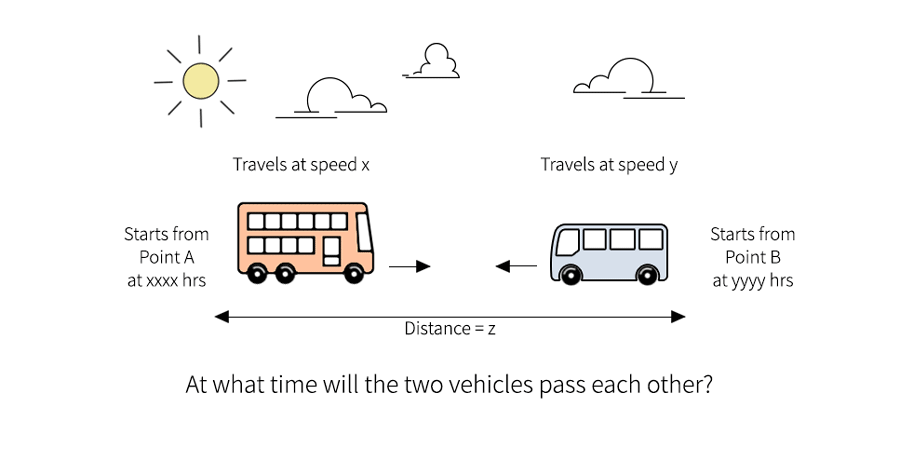This article is written and contributed by Therese Cheng, Academic Director for The Learning Lab Marine Parade Central

If this question looks familiar, it is because this question has stood the test of time.
I tackled it as a student and now my children are tackling it in school. As a primary school student, I remember wondering:
Who cares when they meet?
What will they do when they meet?
Honk at each other?
The relevance of what I was studying was hardly explained to me, and I thought I was not good in Maths, for my struggles in tackling such sums were a surely a sign. Years later when I watched the movie “Deep Impact”, it occurred to me that such sums could perhaps be useful in the event that we needed to calculate when Earth would be hit by an asteroid hurtling our way.
That was my education then — I was just expected to know the skills to answer the questions and pass the examinations and if I did not excel in a subject, I was probably never going to be good at it.
Today, the education landscape has changed drastically. There is a lot more emphasis on the learning process rather than just the end product.
At The Learning Lab, we seek to do the same for our students, through classes that deliver not only knowledge and skills, but also life lessons that our charges can take with them wherever they go.
Here are 5 life lessons that we aim to impart to our students.

Maths is everywhere and solving Maths problems is much like solving problems in real life.
Just last week, I chanced upon a credit card promotion that proved irresistible. Before long, I found myself seated in one of Singapore’s most popular restaurants enjoying a good buffet spread with my whole family, all the while thinking about what good value for money the meal was — a 20% discount that I would enjoy with my credit card.
Alas, when the bill came, I realised that the discount applied to the price before GST and so my savings were not as great as I had expected. I must have muttered my thoughts out loud, for my 10-year-old son, commented, “What did you expect, Mummy? They won’t lose so much money when the discount is taken from a smaller sum of money.”
That comment, uttered in a matter-of-fact manner, left me gaping at him. How could I not have arrived at this epiphany myself earlier? And I was in awe at how the synapses connected in such a way in the young child’s mind.
As it turned out, my son’s Maths class at TLL had a discussion about restaurants and discounts when they were learning about Percentage. That prompted me to find out more about how TLL lessons help connect classroom concepts to real-life situations.
I’ve found that TLL teachers frequently infuse their lessons with real-life, relatable scenarios so that learning happens in a context. This means students learn to apply their knowledge to understanding the world around them.
As a parent, I can attest to the benefits of such teaching methods as I see so clearly in my young son who has taught me a thing or two about jumping headlong on a credit card buffet promotion.

Knowledge around us is hardly isolated. It is important for students to learn to integrate different pieces of knowledge in discussions or analyses — a higher-order skill that will definitely prove valuable in different aspects, whether in class or in life.
Beakers, test tubes, Bunsen burner, litmus paper — these are the usual suspects for conducting experiments in a Science class. But a line-up of diapers of various brands on the table? I must confess that I did a double take when I walked past a classroom with such a set-up.
I later found out that the Primary 3 class was investigating the properties of materials used in the various diapers by pouring a beaker of water into each diaper and measuring the absorbency.
The end task? Determine which brand of diaper is more cost-effective, based on the absorbency experiment and the price of each diaper. Let’s just say it’s worthwhile to pay a little more for diapers.
That was a perfect example of how students learn to integrate knowledge from two separate subjects — namely Science and Maths in this case — to discover something new.

“Elephants’ tusks hacked off!”
“Elephants left to die!”
“Elephant carcasses dot the landscape!”
Do sensational headlines above tug at your heartstrings?
When this was the topic of one of the Primary 4 comprehension passages, students started the lesson hating poachers with a vengeance. Understandably, some were confused when they were asked the following discussion questions:
“Why do you think the poachers do this?”
“Why do you think the poachers have to do this?”
Gradually, one could sense the change in their opinions. While most of the 10-year-olds entered the classroom with a singular hatred for poachers, many left the classroom with newfound perspectives and some even displayed empathy for the poachers. What was valuable was the fact that they learnt to see the issue from different perspectives.
In TLL classrooms, children are encouraged and given many opportunities to take on different perspectives. Ultimately, such a practice broadens their world views and allows them to put themselves in others’ shoes, helping them to become more sensitive and empathetic individuals.

No child is too young to have his or her opinion. This is why we start them from young not only to form their opinions, but also to convey them confidently, precisely and concisely. And this is truly a skill that the children can take with them through life — at interviews, when communicating with others, presenting an important pitch... the list goes on.
Mention the phrase “Media Studies” in an English lesson and the effect is instantaneous. Eyes light up, smiles broaden and the entire class is abuzz with anticipation.
Every carefully selected video is accompanied by critical thinking questions which ask students for their opinions on issues presented in the video, as illustrated by the questions below.
| For Primary 1 students | Would you like to visit the Galapagos Islands? Which animal would you like to learn more about? |
| For Primary 2 students | Pangolins that are rescued are often returned to the wild. Do you agree with this practice? Why? |
| For Primary 3 students | Do you think homes in Singapore should be built from concrete canvas or steel containers? Why or why not? |
Such questions do not have definitive right or wrong answers and that’s because they are meant to encourage students to form opinions and justify them. This way, children learn that their opinions are valuable and meaningful, and gain more confidence in themselves.
In my many years of teaching at TLL, I have personally seen how giving children ample opportunity to share their opinions can help them blossom from meek and scared first-time presenters to confident and articulate communicators.
Consider the following:
“Jayden can do these sums because he's good at Maths. I am not good at Maths so I cannot these sums..” |
vs |
“I cannot do these sums but it does not mean I am not good at Maths. I can find ways to improve so I will be able to do similar sums.” |
As parents, don’t we all want our children to believe in themselves? We want to know that they will be able to face challenges, both in class and in life.
Apart from developing our children’s knowledge and skills, TLL seeks to nurture our students’ disposition as well. One of the ways we do this is by promoting the development of a growth mindset. Having a growth mindset is important in life as it increases motivation and achievement. Such a mindset gives rise to an optimistic outlook rather than a defeatist one.
How do we nurture the growth mindset in our classrooms?

In the TLL classroom, students are frequently asked to reflect on their work performance. Only with self-awareness can there be efforts made to improve oneself.
When students are self-aware of their weaknesses and strengths, they can take positive action to remedy the weakness and hone their strengths to even greater heights.
Students are taught different strategies to complete a task.
For example, when tackling difficult vocabulary, students may be taught how to use the context of the sentence in deciphering the meaning, using the root word or suffixes or even using graphic organisers to better see the nuances between words.
When children are aware of various strategies, their confidence in tackling a difficult problem increases. Instead of relying on a single method and becoming deflated when it fails them, such an attitude will enable them to press on.
We value the learning process as much as we value the outcome. In rewarding efforts made throughout the learning journey, we deliver the message to our charges that their attitude is the key to their success.
For example, in all composition lessons, teachers encourage their students to write a second draft of their compositions. I know of many teachers who award marks for the second drafts too. In doing a second draft and in getting a better grade for it, students learn that they will get better if they apply what they have learnt and if they are receptive to advice.
Even as we give students all they need to learn the right content and skills to succeed in school, The Learning Lab has a vested interest in helping each student see that what they learn in class is applicable to life, too.
You can learn about our alumni’s learning journey with TLL, the life lessons they have taken away from TLL, and how they have blossomed into the fine working professionals they are today by clicking the button below.
With the right knowledge, skills and dispositions, every child can fulfil his or her full potential.
If you would like to find out more about our programmes, email us at enquiry@thelearninglab.com.sg or call us at 6733 8711.